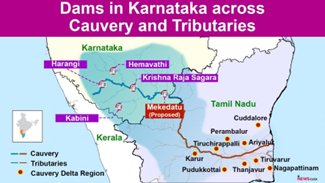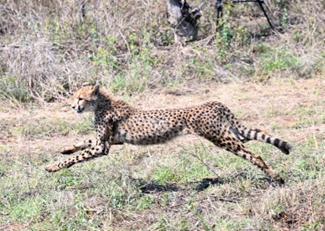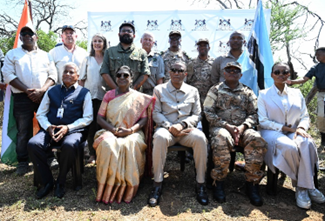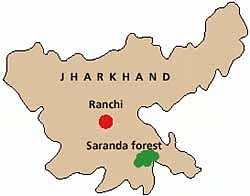Indian Polity
Anti-defection law:
-
- Provided under Tenth Schedule of the Constitution, inserted by the 52nd Constitutional Amendment Act, 1985.
- Objective: Prevent political defections motivated by lure of office or personal gain; ensure stability of governments.
- Grounds for Disqualification:
- Voluntarily giving up membership of the party.
- Voting/abstaining against party whip without prior permission.
- Authority to Decide Disqualification: Speaker/Chairman, but their decision is subject to judicial review (as per Kihoto Hollohan, 1992).
- 91st Constitutional Amendment Act, 2003:
- Removed provision of split (i.e., 1/3rd members).
- Allowed merger only if 2/3rd members agree.
- Criticisms:
- Curtails freedom of speech of legislators.
- Strengthens party leadership over individual MPs/MLAs.
- Delayed decisions by Speaker often lead to political manipulation.
- Reform Suggestions:
- Apply whip only for confidence, no-confidence, money bills, and budget matters (as recommended by several committees including Dinesh Goswami Committee).
- Decisions should be made by an independent tribunal, not Speaker.
(TH)
International Developments
Global Carbon Project:
-
- Context: India’s 2025 carbon emissions have increased slowly compared to last year. While global carbon emissions are expected to rise to 38 billion tonnes, or by 1.1%, this year, the growth in India’s emissions is expected to increase by 1.4%, according to the Global Carbon Project, an authoritative tracker of fossil fuel emissions.
- Establishment: Founded in 2001 as part of the Global Change System for Analysis, Research and Training (START).
- Part of the Global Carbon Initiative, coordinated internationally.
- Objective: To quantify global carbon emissions, sinks, and trends in the carbon cycle.
- To provide policy-relevant information on climate change mitigation.
- Key Activities: Annual Global Carbon Budget publication.
- Tracking carbon dioxide (CO₂) emissions from fossil fuels, land-use change, and oceans.
- Monitoring natural carbon sinks in oceans and terrestrial ecosystems.
- Significance: Provides scientific basis for global climate negotiations, including UNFCCC and COP meetings.
- Helps nations track progress toward emission reduction targets.
- Supports research on global warming, climate change impacts, and carbon management strategies.
- Collaborations: Works with international scientists, research institutions, and climate organizations.
(TH)
Geography, Mapping, Ecology & Environment
Mekedatu Reservoir:
-
- Location: Mekedatu is located on the Cauvery River, in Ramanagara district, Karnataka, near the border with Tamil Nadu.
- Purpose:
- Proposed as a multipurpose project for drinking water supply, hydropower generation, and irrigation.
- Intended primarily to supply drinking water to Bengaluru city.
- Controversy / Inter-State Issue:
- It is disputed between Karnataka and Tamil Nadu.
- Tamil Nadu claims it violates the Cauvery Water Dispute Tribunal (CWDT) award and affects water sharing.
- Karnataka maintains it is a balancing reservoir, not a diversion, and for drinking water purposes only.
- Environmental and Social Concerns:
- Potential submergence of forests and impact on wildlife in the Mekedatu gorge area.
- Possible displacement of local communities and impact on riverine ecology.
- Strategic Importance:
- Crucial for Bengaluru’s water security.
- Part of Karnataka’s plan to manage water resources amid increasing urban water demand.

(TH)
Botswana gifts india eight cheetahs for next phase of project cheetah:
-
- On 13 November 2025, Droupadi Murmu (President of India) and Duma Gideon Boko (President of Botswana) visited Mokolodi Nature Reserve in Botswana where a symbolic release of eight cheetahs (from the Ghanzi region) was witnessed, marking Botswana’s gift of eight cheetahs to India under Project Cheetah.


-
- About Project Cheetah:
- Launched in 2022, Project Cheetah aims to reintroduce the cheetah in India, after it went extinct in 1952.
- Implemented by National Tiger Conservation Authority (NTCA) under the Ministry of Environment, Forest and Climate Change (MoEFCC).
- Conducted in collaboration with international partners like Namibia and South Africa, which supplied the first batches of cheetahs.
- Kuno National Park (Madhya Pradesh) is the primary site selected for cheetah introduction.
- Uses principles of IUCN-guided species reintroduction and metapopulation management.
- Objective: to establish a self-sustaining cheetah population, restore grassland ecosystems, and improve habitat-based conservation.
- About Project Cheetah:
(TH)
Saranda forest area:
-
- Context: The Supreme Court directed the Jharkhand government to declare 31,468.25 hectares (approximately 314 sq. km.) of the Saranda forest area as a wildlife sanctuary, balancing biodiversity protection with sustainable iron ore mining.
- Located in West Singhbhum district, Jharkhand; known as India’s largest Sal (Shorea robusta) forest.
- Part of the Chota Nagpur Plateau.
- It is home to critically endangered species, including the endemic sal forest tortoise, four-horned antelope, Asian palm civet, and wild elephants.
- For centuries, the area has been inhabited by the Ho, Munda, Uraon and allied Adivasi communities whose subsistence and cultural traditions are intrinsically tied to forest produce.
- The Saranda forest division also accounts for 26% of India’s iron ore reserves (notably in Chiria and Kiriburu–Meghahatuburu belts).
- The steel plants of SAIL and Tata are critically dependent on mining in this area.
- Faces threats from deforestation, mining-induced degradation, and loss of tribal livelihoods.
- Saranda Development Plan (SDP) was launched by the Government of India to restore ecology, curb illegal mining, and support tribal communities in Naxal-affected areas.
- Ecologically important as a catchment for the Koina and Karo rivers, supporting local hydrology.
- Classified as an Elephant Habitat Zone, facing frequent human–elephant conflict.

(TH)
Terms in news
(Ethics)- Rational religiosity:
-
- Refers to a balanced approach to religion where beliefs and practices are guided by reason, ethics, and critical thinking rather than blind faith.
- Emphasizes universal values such as compassion, non-violence, social justice, and human dignity over ritualism or dogma.
- Aligns with constitutional principles such as scientific temper (Art. 51A(h)), secularism, and freedom of conscience.
- Encourages interfaith harmony, tolerance, and rejection of superstition or extremist interpretations.
- Supports evidence-based decision-making in public policy while respecting cultural and religious diversity.
- Often discussed in the context of social reformers (e.g., Swami Vivekananda, Raja Rammohan Roy, Mahatma Gandhi) who advocated spiritual values grounded in reason.
(TH)
Important data/facts
Geography & Environment
-
- India is the third largest emitter of carbon at 3.2 billion tonnes annually (2024), led by the U.S. (4.9 billion tonnes) and China (12 billion tonnes). India’s per capita emission is 2.2 tonnes of carbon dioxide per year, the second lowest among 20 of the largest economies globally.
PRACTICE MCQ’S
Q1. Mekedatu Reservoir, often in news due to inter-state water disputes, is associated with which of the following rivers?
a) Krishna
b) Godavari
c) Cauvery
d) Tungabhadra
Answer: C
Explanation:
-
- Mekedatu is a proposed multipurpose reservoir on the Cauvery River in Ramanagara district, Karnataka, near the Tamil Nadu border.
- The project aims for drinking water supply, irrigation, and hydropower, and is currently disputed between Karnataka and Tamil Nadu.
Q2. With reference to Project Cheetah, consider the following statements:
1. The African cheetahs introduced in India belong to a subspecies classified as Vulnerable under the IUCN Red List.
2. The project incorporates a “soft-release” protocol, where cheetahs are kept in acclimatisation enclosures before full release.
3. One of the ecological objectives of Project Cheetah is to restore India’s open forest and grassland ecosystems.
4. The project is fully funded through the Compensatory Afforestation Fund Management and Planning Authority (CAMPA).
Which of the above statements are correct?
a) 1, 2 and 3 only
b) 1 and 4 only
c) 2 and 3 only
d) 1, 2, 3 and 4
Answer: A
Explanation:
-
- Statement 1 is correct: The African cheetah (Acinonyx jubatus jubatus) is listed as Vulnerable on the IUCN Red List.
- Statement 2 is correct: Project Cheetah uses a soft-release process; cheetahs spend weeks/months in acclimatisation bomas before open release.
- Statement 3 is correct: Restoring grassland and savanna habitats is a major ecological goal.
- Statement 4 is incorrect: The project is not fully funded through CAMPA; funding comes from multiple sources, including central government allocations and partner-country support.
Q3. The Global Carbon Project (GCP), often mentioned in climate change discussions, primarily focuses on:
a) Developing renewable energy technologies for global use.
b) Quantifying global carbon emissions, sinks, and trends in the carbon cycle.
c) Regulating international trade in carbon credits under the Kyoto Protocol.
d) Funding national reforestation projects in tropical countries.
Answer: B
Explanation:
Option B is correct: GCP tracks carbon emissions from fossil fuels, land-use changes, and oceans, and publishes the annual Global Carbon Budget.
Options A, C, and D are incorrect: GCP does not develop technologies, regulate carbon trading, or fund national reforestation projects; it focuses on scientific assessment and monitoring.
Q4. With reference to the Saranda Forest, consider the following statements:
1. Saranda Forest is located in the Chota Nagpur Plateau region of Jharkhand.
2. It is known as India’s largest Sal Forest.
3. The region is rich in iron ore deposits, leading to extensive mining activity.
4. The Saranda Forest forms the catchment area for the Konar River.
Which of the above statements are correct?
a) 1 and 2 only
b) 1, 2 and 3 only
c) 2, 3 and 4 only
d) 1, 3 and 4 only
Answer: B
Explanation:
-
- Statement 1 is correct: Saranda Forest lies in West Singhbhum, Jharkhand, part of the Chota Nagpur Plateau.
- Statement 2 is correct: It is famous as India’s largest Sal forest (Shorea robusta).
- Statement 3 is correct: The area has abundant iron ore, with mines like Kiriburu, Meghahatuburu, and Chiria.
- Statement 4 is incorrect: Saranda is a catchment for the Koina and Karo rivers, not the Konar.
Q5. The term “Rational Religiosity” is best understood as:
a) Strict adherence to religious rituals based on traditional authority.
b) A form of religious belief that incorporates reason, ethical values, and critical thinking.
c) Replacement of all religious practices with scientific principles.
d) Establishment of a state religion based on rational philosophy.
Answer: B
Explanation:
-
- Option B is correct: Rational religiosity means approaching religion with reason, ethics, and balanced judgment, avoiding blind faith or superstition.
- Option A is incorrect: It refers to ritualism, not rationality.
- Option C is incorrect: Rational religiosity does not reject religion, it harmonizes it with reason.
- Option D is incorrect: It has nothing to do with establishing a state religion.
Q6. With reference to anti-defection law, consider the following:
| List I (Aspect of Anti-Defection Law) | List II (Details / Provision) |
|---|---|
| A. The Act was added through | 1. Speaker/Chairman |
| B. Authority to decide disqualification | 2. 91st Amendment Act, 2003 |
| C. Party merger provision | 3. 52nd Amendment Act, 1985 |
| D. Applicability of whip | 4. Only on confidence, no-confidence, money bills |
Codes:
a) A-1, B-2, C-3, D-4
b) A-3, B-1, C-2, D-4
c) A-2, B-3, C-1, D-4
d) A-3, B-2, C-1, D-4
Answer: B
Explanation:
A → 3: Anti-Defection Law added by 52nd Amendment Act, 1985.
B → 1: Disqualification decided by Speaker/Chairman, subject to judicial review.
C → 2: Merger allowed if two-thirds members agree (91st Amendment Act, 2003).
D → 4: Whip applicable only on confidence, no-confidence, money bills.
Spread the Word
